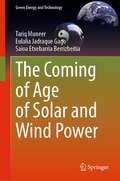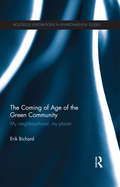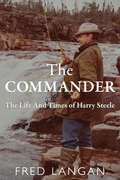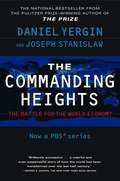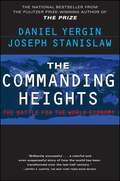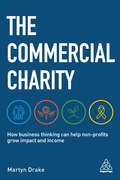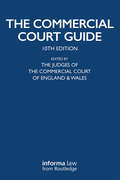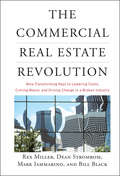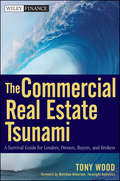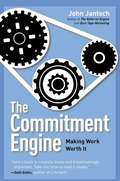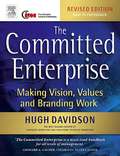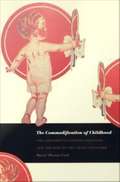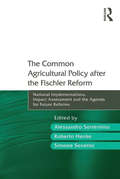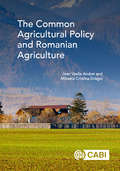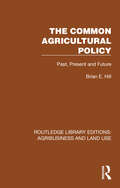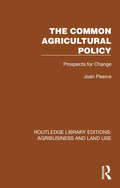- Table View
- List View
The Coming of Age of Solar and Wind Power (Green Energy and Technology)
by Tariq Muneer Eulalia Jadraque Gago Saioa Etxebarria BerrizbeitiaThis book focuses on the current situation of two technologies for electricity production from renewable energy sources, wind and solar photovoltaic energy, analysing and describing both technologies in detail. Four regions of the world, with distinct energy markets and conditions, are explored. Together, the USA, Europe, China and Japan represent one third of the world’s population and occupy 25% of the planet, therefore offering a representation of a global picture. In each of these regions, the development of the solar and wind energy is examined, and the economic implications are described.
The Coming of Age of the Green Community: My neighbourhood, my planet (Routledge Explorations in Environmental Studies)
by Erik BichardPeople organising to protect their environment is not a new phenomenon, but the groups that have been pushing for environmental change since the 1970s have not convinced sufficient numbers make sustainable decisions or to lead sustainable lives. Governments have serially failed to do the job at the international level. Now, climate change, resource depletion and widening social aspirations threaten to destabilise human society unless sustainable change can be influenced from another direction. The Coming of Age of the Green Community explores the activities of a new generation of community-led initiatives that may herald the beginnings of the next wave of activism. Erik Bichard combines the testimonies of dozens of group activists with historic evidence and the views of a range of commentators from a variety of disciplines to put forward reasons why some green community groups succeed while others fail. He concludes with a valuable prescription for both existing and emerging groups on how to be sustainable, both over time and in their actions. This book address one of the key questions of the twenty-first century: has the local perspective on this universal concern finally come of age?
The Coming of the Railway: A New Global History, 1750-1850
by David GwynThe first global history of the epic early days of the iron railway Railways, in simple wooden or stone form, have existed since prehistory. But from the 1750s onward the introduction of iron rails led to a dramatic technological evolution—one that would truly change the world. In this rich new history, David Gwyn tells the neglected story of the early iron railway from a global perspective. Driven by a combination of ruthless enterprise, brilliant experimenters, and international cooperation, railway construction began to expand across the world with astonishing rapidity. From Britain to Australia, Russia to America, railways would bind together cities, nations, and entire continents. Rail was a tool of industry and empire as well as, eventually, passenger transport, and developments in technology occurred at breakneck speed—even if the first locomotive in America could muster only 6 mph. The Coming of the Railway explores these fascinating developments, documenting the early railway&’s outsize social, political, and economic impact—carving out the shape of the global economy as we know it today.
The Commander: The Life And Times of Harry Steele
by Fred LanganOne of Canada’s great entrepreneurial success stories Harry Steele was born in Musgrave Harbour, an isolated outport on the eastern coast of Newfoundland. He went to university, joined the naval reserve, and became a lieutenant-commander in the Royal Canadian Navy. Harry quit in 1974 — he didn’t like the new green uniforms — and went into business. Using money he made in the stock market and his wife Catherine’s real estate investments, Harry bought control of struggling Eastern Provincial Airways. He made it a success and sold it to CP Air several years later. Harry was also highly successful with his other investments, which included the trucking and ferry service company Clarke Transport and the radio broadcasting company Newfoundland Capital Corporation. With a long list of successes, Harry Steele stays true to his roots, living in Gander, Newfoundland.
The Commanding Heights
by Daniel YerginThe Commanding Heights is about the most powerful political and economic force in the world today -- the epic struggle between government and the marketplace that has, over the last twenty years, turned the world upside down and dramatically transformed our lives. Now, the Pulitzer Prize-winning author of The Prize joins with a leading expert on the new marketplace to explain the revolution in ideas that is reshaping the modern world. Written with the same sweeping narrative power that made The Prize an enormous success, The Commanding Heights provides the historical perspective, the global vision, and the insight to help us understand the tumult of the past half century. Trillions of dollars in assets and fundamental political power are changing hands as free markets wrest control from government of the "commanding heights" -- the dominant businesses and industries of the world economy. Daniel Yergin and Joseph Stanislaw demonstrate that words like "privatization" and "deregulation" are inadequate to describe the enormous upheaval that is unfolding before our eyes. Along with the creation of vast new wealth, the map of the global economy is being redrawn. Indeed, the very structure of society is changing. New markets and new opportunities have brought great new risks as well. How has all this come about? Who are the major figures behind it? How does it affect our lives? The collapse of the Soviet Union, the awesome rise of China, the awakening of India, economic revival in Latin America, the march toward the European Union -- all are a part of this political and economic revolution. Fiscal realities and financial markets are relentlessly propelling deregulation; achieving a new balance between government and marketplace will be the major political challenge in the coming years. Looking back, the authors describe how the old balance was overturned, and by whom. Looking forward, they explore these questions: Will the new balance prevail? Or does the free market contain the seeds of its own destruction? Will there be a backlash against any excesses of the free market? And finally, The Commanding Heights illuminates the five tests by which the success or failure of all these changes can be measured, and defines the key issues as we enter the twenty-first century. The Commanding Heights captures this revolution in ideas in riveting accounts of the history and the politics of the postwar years and compelling tales of the astute politicians, brilliant thinkers, and tenacious businessmen who brought these changes about. Margaret Thatcher, Donald Reagan, Deng Xiaoping, and Bill Clinton share the stage with the "Minister of Thought" Keith Joseph, the broommaker's son Domingo Cavallo, and Friedrich von Hayek, the Austrian economist who was determined to win the twenty-year "battle of ideas. " It is a complex and wide-ranging story, and the authors tell it brilliantly, with a deep understanding of human character, making critically important ideas lucid and accessible. Written with unique access to many of the key players, The Commanding Heights, like no other book, brings us an understanding of the last half of the twentieth century -- and sheds a powerful light on what lies ahead in the twenty-first century.
The Commanding Heights: The Battle for the World Economy
by Daniel Yergin Joseph StanislawThe Commanding Heights is about the most powerful political and economic force in the world today -- the epic struggle between government and the marketplace that has, over the last twenty years, turned the world upside down and dramatically transformed our lives. Now, the Pulitzer Prize-winning author of The Prize joins with a leading expert on the new marketplace to explain the revolution in ideas that is reshaping the modern world. Written with the same sweeping narrative power that made The Prize an enormous success, The Commanding Heights provides the historical perspective, the global vision, and the insight to help us understand the tumult of the past half century. Trillions of dollars in assets and fundamental political power are changing hands as free markets wrest control from government of the "commanding heights" -- the dominant businesses and industries of the world economy. Daniel Yergin and Joseph Stanislaw demonstrate that words like "privatization" and "deregulation" are inadequate to describe the enormous upheaval that is unfolding before our eyes. Along with the creation of vast new wealth, the map of the global economy is being redrawn. Indeed, the very structure of society is changing. New markets and new opportunities have brought great new risks as well. How has all this come about? Who are the major figures behind it? How does it affect our lives? The collapse of the Soviet Union, the awesome rise of China, the awakening of India, economic revival in Latin America, the march toward the European Union -- all are a part of this political and economic revolution. Fiscal realities and financial markets are relentlessly propelling deregulation; achieving a new balance between government and marketplace will be the major political challenge in the coming years. Looking back, the authors describe how the old balance was overturned, and by whom. Looking forward, they explore these questions: Will the new balance prevail? Or does the free market contain the seeds of its own destruction? Will there be a backlash against any excesses of the free market? And finally, The Commanding Heights illuminates the five tests by which the success or failure of all these changes can be measured, and defines the key issues as we enter the twenty-first century. The Commanding Heights captures this revolution in ideas in riveting accounts of the history and the politics of the postwar years and compelling tales of the astute politicians, brilliant thinkers, and tenacious businessmen who brought these changes about. Margaret Thatcher, Donald Reagan, Deng Xiaoping, and Bill Clinton share the stage with the "Minister of Thought" Keith Joseph, the broommaker's son Domingo Cavallo, and Friedrich von Hayek, the Austrian economist who was determined to win the twenty-year "battle of ideas." It is a complex and wide-ranging story, and the authors tell it brilliantly, with a deep understanding of human character, making critically important ideas lucid and accessible. Written with unique access to many of the key players, The Commanding Heights, like no other book, brings us an understanding of the last half of the twentieth century -- and sheds a powerful light on what lies ahead in the twenty-first century.
The Commercial Aircraft Finance Handbook
by Ronald ScheinbergThe Commercial Aircraft Finance Handbook is a resource for every type of aircraft finance practitioner - seasoned and starter alike. The handbook offers a comprehensive overview of the multifaceted matters that arise in the process of financing commercial aircraft. The book clearly reviews the different topics on a high-level basis, and then explains the terminology used for each particular area of specialization.. It can be used as both a learning aid and reference resource. The area of commercial aircraft finance is multidisciplinary one, touching professionals across law, finance, insurance, and leasing (to name a few) and this book arms these diverse practitioners with a framework for knowing the questions and issues that should be considered in an aircraft financing transaction. This book will also provide practitioners just starting out in this field with an introduction to the myriad of topics in aircraft finance while providing more seasoned professionals with explanations of matters outside their normal area of expertise. As well, all practitioners will benefit from the resources provided in the appendices.
The Commercial Charity: How Business Thinking Can Help Non-Profits Grow Impact and Income
by Martyn DrakeContrary to popular perception, charities and non-profits now generate over half their total income by selling goods and professional services. Charities of all shapes and sizes are increasingly targeting commercial growth to help fulfil their aims, and commercial income within the sector has doubled since the year 2000. Big opportunities exist, and The Commercial Charity will help any professional in the sector to take advantage of them and increase the social and financial impact of their organization.Using a wealth of examples, The Commercial Charity demonstrates the wider societal benefits of taking a professional approach to commercial income and harnessing business to bring about change. It provides a process for creating a clear, integrated strategy, outlining a methodology for developing ideas and scaling innovations, while providing an ethical model for marketing and selling them. With interviews from leaders of many of the most successful charities including the National Autistic Society, NSPCC and British Asian Trust, this book will show readers how to evolve their organization into a professional, commercially-adept non-profit. Ultimately, readers will learn how to successfully use business principles and techniques not just to raise money, but to create long lasting and self-sustaining social impact.
The Commercial Court Guide: (incorporating The Admiralty Court Guide) with The Financial List Guide and The Circuit Commercial (Mercantile) Court Guide
by The Hon. KnowlesAvailable for the first time in one easy-to-read printed volume, The Commercial Court Guide contains all materials needed when appearing in the Commercial Court or the Admiralty Court. Compiled by an eminent team of judges, it is an indispensable tool for users of those courts.
The Commercial Real Estate Revolution
by Rex Miller Bill Black Dean Strombom Mark IammarinoAs it currently operates, the commercial real estate construction industry is a disaster full of built-in waste. Seventy-percent of all projects end over budget and late. The buildingSMART Alliance estimates that up to fifty-percent of the process is consumed in waste. Almost every project includes massive hidden taxes in the form of delays, cost overruns, poor quality, and work that has to be redone. Building new structures is a fragmented, adversarial process that commonly results in dissatisfied customers and frequently ends in disappointment, bitterness, and even litigation.The industry must change--for its own good and that of its customers. But while the industry has tried to reform itself, it can't do it alone. Real change can only come from business owners and executives who refuse to continue paying for a dysfunctional system and demand a new way of doing business.The Commercial Real Estate Revolution is a bold manifesto for change from the Mindshift consortium--a group of top commercial real estate industry leaders who are fed up with a system that simply doesn't work. The book explains how business leaders can implement nine principles for any project that will dramatically cut costs, end delays, create better buildings, and force the industry into real reform.The Commercial Real Estate Revolution offers a radically new way of doing business--a beginning-to-end, trust-based methodology that transforms the building process from top to bottom. Based on unifying principles and a common framework that meets the needs of all stakeholders, this new system can reform and remake commercial construction into an industry we're proud to be a part of.If you're one of the millions of hardcore cynics who work in commercial construction, you probably think this sounds like pie in the sky. But this is no magic bullet; it's a call for real reform. If you're an industry professional who's sick of letting down clients or an owner who's sick of cost overruns and endless delays, The Commercial Real Estate Revolution offers a blueprint for fixing a broken industry.
The Commercial Real Estate Tsunami
by Matthew Anderson Tony WoodAn in-depth look at why a commercial real estate collapse is inevitable, and how to survive it The Commercial Real Estate Tsunami is the first book to address the phenomenon of the pending wave of commercial debt maturities coming due in the next five years, and the impact those maturities will have on the commercial real estate markets when combined with the historic economic crisis the world is experiencing at this time. Drawing on the knowledge of recognized experts in the commercial real estate industry and financial markets, as well as lessons learned from the commercial real estate downturns of the 1980s and 1990s, author Tony Wood fills a void in our understanding of the causes of the crisis and what to expect in the future. Sends a warning to the commercial real estate industry, and offers concrete solutions to mitigate the risks and hazards that lie ahead Contains the insights of a group of experts from various sectors of the commercial real estate industry Helps market participants, including investors, developers, lenders, and brokers, gain a vitally needed perspective on where we might be going next and how we will get there Heeding the advice and guidance of the contributors in this book will benefit anyone navigating these turbulent waters and help lead them to higher ground.
The Commercialisation of Space: Politics, Economics and Ethics (Space Power and Politics)
by Thomas Hoerber Sarah Lieberman Harald Köpping AthanasopoulosThis interdisciplinary book examines the impact of the commercialisation of space and the changing outlook of the space sector. Using a framework based around theories of international political economy (IPE), the chapters take on issues relating to the politics, the economics and the ethics of commercialising space. The book aims to build a bridge between the research carried out on European Space Policy and the issues that are currently pertinent in the global discussion of future space policy. Overall, the volume aims to: • inform the reader about historical and contemporary developments in the neoliberal commercialisation of space; • assess the impact of the commercialisation of space on European space institutions, European space policy and European space culture; • raise ethical questions about the environmental and practical sustainability of the commercialisation of space; • examine the compatibility of the commercialisation of space with international, EU and national law. This book will be of much interest to students of space policy, global governance, European politics and International Relations.
The Commission on Presidential Debates
by Boris Groysberg Kerry Herman Alexis Lefort Joshua GroysbergThe Commission on Presidential Debates (CPD) has organized the presidential and vice-presidential debates in the United States since 1988. In the spring of 2022, the Republican National Committee threatened to bar their nominees from participating in any CPD-sponsored debates in the upcoming election. The CPD must decide how to handle this challenge.
The Commitment Engine: Making Work Worth It
by John JantschThe small-business guru behind Duct Tape Marketing and The Referral Engine teaches readers how to establish lasting commitment in their employees, customers, and businesses. Why are some companies able to generate committed, long-term customers while others struggle to stay afloat? Why do the employees of some organizations fully dedicate themselves while others punch the clock without enthusiasm? By studying the ins and outs of companies that enjoy extraordinary loyalty from customers and employees, John Jantsch reveals the systematic path to discovering and generating genuine commitment. Jantsch’s approach is built on three foundational planks, which he calls the clarity path, the culture patron, and the customer promise. He draws on his own experiences and shares true stories from businesses like Threadless, Evernote, and Warby Parker. His strategies include these: Build your company around a purpose. People commit to companies and stories that have a simple, straightforward purpose. Understand that culture equals brand. Build your business as a brand that employees and customers will support. Lead by telling great stories. You can’t attract the right people or get them to commit without telling a story about why you do what you do. Treat your staff as your customer. A healthy customer community is the natural result of a healthy internal culture. Serve customers you respect. It’s hard to have an authentic relationship with people you don’t know, like, or trust. As Jantsch says, “Have you ever encountered a business where everything felt effortless? The experience was perfect, and the products, people, and brand worked together gracefully. You made an odd request; it was greeted with a smile. You went to try a new feature; it was right where it should be. You walked in, sat down, and felt right at home. . . . Businesses that run so smoothly as to seem self-managed aren’t normal. In fact, they are terribly counterintuitive, but terribly simple as it turns out. ” As a follow-up to The Referral Engine, this is about more than just establishing leads— it’s about building a fully alive business that attracts customers for life. .
The Committed Enterprise: How To Make Vision And Values Work
by Hugh DavidsonIt is easier to describe vision and values than implement them. However this updated paperback edition of The Committed Enterprise shows how to achieve success by understanding the needs of stakeholders and maximising them. It details the Seven Best Practices for making vision and values work and is based on research with leaders from 125 leading enterprises worldwide. Using a unique format to allow fast track or in-depth reading the book includes hundreds of examples from enterprises as diverse as PepsiCo, Caltech, Tesco, Mayo Clinic, BP, New York Police Department, DuPont, UPS and many others. The text is essential reading for managers, and students of strategic organisational strategy.
The Committee to Destroy the World: Inside the Plot to Unleash a Super Crash on the Global Economy
by Michael E. LewittAn updated examination of what's weakening the U.S. economy, and how to fix itThe Committee to Destroy the World: Inside the Plot to Unleash a Super Crash on the Global Economy is a passionate and informed analysis of the struggling global economy. In this masterfully conceived and executed work, Michael Lewitt, one of Wall Street's most respected market strategists and money managers, updates his groundbreaking examination of the causes of the 2008 crisis and argues that economic and geopolitical conditions are even more unstable today. His analysis arrives in time for the impending economic and geopolitical debates of the 2016 election season. Lewitt explains in detail how debt has now overrun the world's capacity, how federal policies of the past few decades have created a downward vortex sapping growth and vitality from the American economy, and how greed and corruption are preventing reform. The financial crisis created tens of trillions of debt, leaving investors to pay a huge price for these policy failures: The highest asset inflation we've seen in our lifetimes, although the government claims there isn't enough inflation More than $2 trillion of stock buybacks funded with low cost debt that are artificially inflating stock prices The Federal Reserve and other global central banks becoming the largest buyers of government debt in order to suppress interest rates An M&A boom resulting from companies needing to find growth outside of their core businesses While the financial media misses the story, Lewitt pulls no punches explaining how all of these trends are leading to the brink of another crisis. Lewitt lays out a survival plan for the average investor to protect their assets when the debt bubble bursts. The first edition of this book expressed hope that policymakers would not let the financial crisis go to waste. This book urges investors to learn from the crushed hope and take action before the next crisis.
The Commodification of Childhood: The Children's Clothing Industry and the Rise of the Child Consumer
by Daniel Thomas CookIn this revealing social history, Daniel Thomas Cook explores the roots of children's consumer culture--and the commodification of childhood itself--by looking at the rise, growth, and segmentation of the children's clothing industry. Cook describes how in the early twentieth century merchants, manufacturers, and advertisers of children's clothing began to aim commercial messages at the child rather than the mother. Cook situates this fundamental shift in perspective within the broader transformation of the child into a legitimate, individualized, self-contained consumer. The Commodification of Childhood begins with the publication of the children's wear industry's first trade journal, The Infants' Department, in 1917 and extends into the early 1960s, by which time the changes Cook chronicles were largely complete. Analyzing trade journals and other documentary sources, Cook shows how the industry created a market by developing and promulgating new understandings of the "nature," needs, and motivations of the child consumer. He discusses various ways that discursive constructions of the consuming child were made material: in the creation of separate children's clothing departments, in their segmentation and layout by age and gender gradations (such as infant, toddler, boys, girls, tweens, and teens), in merchants' treatment of children as individuals on the retail floor, and in displays designed to appeal directly to children. Ultimately, The Commodification of Childhood provides a compelling argument that any consideration of "the child" must necessarily take into account how childhood came to be understood through, and structured by, a market idiom.
The Common Agricultural Policy after the Fischler Reform: National Implementations, Impact Assessment and the Agenda for Future Reforms
by Alessandro Sorrentino Roberto HenkeProviding an updated state of the art report on the effects of the 2003 Common Agricultural Policy (CAP) reform, this volume has a particular emphasis on the governance of institutional changes and national/regional implementation. Written from an agricultural economist's point of view and enriched by the contribution of political scientists and policy makers, this book offers: - an updated report of the European debate on agricultural and rural policies; -an in-depth analysis of the decoupling process of the agricultural financial support in Europe; - an analysis of the CAP implementation in the old and new Europe Member States ; - a discussion on the future scenarios for the European Agricultural Policies Based on a selection of papers from the 109th Seminar of the European Association of the Agricultural Economists (EAAE), this book, with a foreword by Franz Fischler, also includes four commissioned contributions from leaders in the field including Sofia Davidova, Roberto Esposti, Tassos Haniotis and Johan Swinnen.
The Common Agricultural Policy and Romanian Agriculture
by Jean Vasile Andrei Mihaela Cristina DragoiThe current evolution of the European economy suggests that in the near future, research in agri-food economy and agri-food production, and agricultural production systems and structures must be redesigned, adapted and developed to respond to the lack of sustainability of agri-food production systems and the current global food crisis. This book analyses the agricultural paradigm transformations that occur as countries converge on the European agricultural model and what their impact is for sectoral development, while emphasizing their contribution to the redefinition of rural agricultural communities and economy. This book helps develop a theoretical framework by analysing the specialized empirical literature and techniques used in the field of agricultural economy research, with a focus on the transformation of Romanian agriculture in order to become integrated and respond to the globalization of markets. presents, analyses and discusses the main theories in field of agricultural economics and paradigms; creates a working paradigm for this concept within agricultural economics; provides a theoretical framework for the agricultural model. The book is aimed at students and researchers in agricultural economics, and government and policy makers internationally.
The Common Agricultural Policy: Past, Present and Future (Routledge Library Editions: Agribusiness and Land Use #14)
by Brian E. HillOriginally published in 1984, this book provides an introduction to the history of agriculture in Western Europe, states the case for government intervention and analyses the operation of the Common Agricultural Policy (CAP) during the late 20th Century. It concludes that the costs of the policy fell heavily on the poorer consumers, food prices were artificially high and surpluses sold at a loss on the world markets. In the light of Britain’s departure from the EU and the EU CAP this book, which also examined the prospects for the future has an enduring relevance.
The Common Agricultural Policy: Prospects for Change (Routledge Library Editions: Agribusiness and Land Use #20)
by Joan PearceOriginally published in 1981, at a time when the EEC’s Common Agricultural Policy had remained largely unchanged, this book examines the criticisms of the CAP and analyses the pressures emanating from the budget and the various options which were available for tackling them. It then outlines the approaches that individual member states and others were likely to adopt, and assesses whether the need for action on the budget will be used as an opportunity to revise the CAP.
The Common Good
by Robert B. ReichFrom the best-selling author of Saving Capitalism and The Work of Nations, a passionate, clear-eyed manifesto on why we must restore the idea of the common good to the center of our economics and politics.With the warmth and lucidity that have made him one of our most important public voices, Robert B. Reich makes the case for a generous, inclusive understanding of the American project, centering on the moral obligations of citizenship. Rooting his argument in everyday reality and common sense, Reich demonstrates the existence of a common good, and argues that it is this that defines a society or a nation. Societies and nations undergo virtuous cycles that reinforce and build the common good, as well as vicious cycles that undermine it. Over the course of the past five decades, Reich contends, America has been in a slowly accelerating vicious cycle--one that can and must be reversed. But first we need to weigh what really matters, and how we as a country should relate to honor, shame, patriotism, truth, and the meaning of leadership.Powerful, urgent, and utterly vital, this is a heartfelt missive from one of our foremost political thinkers: a fundamental statement about the purpose of society and a cri de coeur to save America's soul.
The Common Good: Rising of a New Dawn: How Living a More Conscious Life Can Heal a Nation One Heart, One Mind, One Thought at a Time
by Juanita S. FarrowAn inspiring guide about how our daily decisions can turn hate and fear into hope and love. The Common Good: Rising of a New Dawn will forever change how you see your neighbor. On this captivating spiritual journey through America, hear the stories of how ordinary people—people in the trenches devoted to the common good—are making an extraordinary difference in the lives of many. With passion, wit, and wisdom, Juanita Farrow discusses business, politics, and religion, and paints a compelling picture of how the common good is God&’s desire for America, and why it&’s good for America. Juanita Farrow states, &“We live in a great country, but far too often we allow our beliefs and egos to divide us in ways that become a form of paralysis that impacts the entire nation.&” Explore how the people in our lives and the experiences of our journey begin to shape our decisions and our view of the world. The Common Good speaks to people of faith and nonbelievers, and challenges everyone to look within for authentic purpose. It looks at pressing issues for Americans, but also the rising of a new dawn. Building the bridges to transcend differences will require a lot of heart. Creating a movement for the common good will be difficult, but even businesses, for instance, have found social entrepreneurship not only solves problems around the world, but is good for the bottom line. The Common Good describes how living a more conscious life can heal a nation—one heart, one mind, one thought at a time. A message of hope on how to turn fear into love, it can leave you feeling truly empowered—and inspired to make a difference.
The Common Law
by Oliver Wendell Holmes Jr.Oliver Wendell Holmes, Jr. (1841-1935) is generally considered one of the two greatest justices of the United States Supreme Court, Chief Justice John Marshall being the other. In more than 2000 opinions, he delineated an impressive legal philosophy that profoundly influenced American jurisprudence, particularly in the area of civil liberties and judicial restraint. At the same time, his abilities as a prose stylist earned him a position among the literary elite.In The Common Law, derived from a series of lectures delivered at the Lowell Institute in Boston, Holmes systematized his early legal doctrines. The result was an enduring classic of legal philosophy that continues to be read and consulted over a century later. Beginning with historical forms of liability (thought to have originated in the desire for vengeance in ancient Roman and Germanic blood feuds), the book goes on to discuss criminal law, torts, bails, possession and ownership, contracts, successions, and many other aspects of civil and criminal law.Encompassing Holmes's profound, wide-ranging knowledge of the law in its historical aspects, yet written in a manner easily accessible to the layman, The Common Law provoked this observation from another famed jurist; "The book is a classic in the sense that its stock of ideas has been absorbed and become part of common juristic thought ... they placed law in a perspective which legal scholarship ever since has merely confirmed." -- Felix Frankfurter, Of Law and Men.Now the influential ideas and judicial theory of Oliver Wendell Holmes, Jr. can be studied and appreciated in this superb edition -- the only one in print -- of his magnum opus. This edition also features a new introduction by Professor Sheldon M. Novick, author of Honorable Justice: The Life of Oliver Wendell Holmes. First published in 1881, this book is still indispensable reading for lawyers, political scientists, historians, general readers -- anyone interested in the origins, development, and continuing evolution of the laws that govern human society.
The Common Path to Uncommon Success: A Roadmap to Financial Freedom and Fulfillment
by John Lee DumasSay hello to YOUR version of uncommon success with a revolutionary 17-step roadmap to guide your journey to financial, location, and lifestyle freedom!Based on thousands of interviews from John Lee Dumas&’ highly acclaimed podcast, Entrepreneurs on Fire, this revolutionary 17-step roadmap provides a proven path for entrepreneurs like you to achieve the financial, location, and lifestyle freedom you are capable of. Let The Common Path to Uncommon Success show you how.The Common Path to Uncommon Success will:Reveal the critical steps successful entrepreneurs take to achieve uncommon success.Dispel the doubts and fear you&’re currently facing while providing a clear path to financial freedom and fulfillment.Ensure you avoid the pitfalls that have tripped up countless entrepreneurs.Provide a &“Well of Knowledge&” section for you to tap into anytime you're in need of inspiration or motivation!JLD&’s 17-step roadmap will help you accomplish your #1 goal in life, as it has for so many others, by showing you how to properly focus on your vision of success until it becomes your reality.
